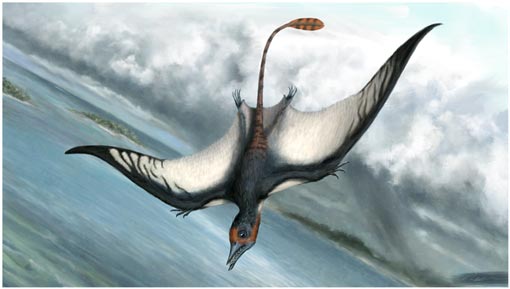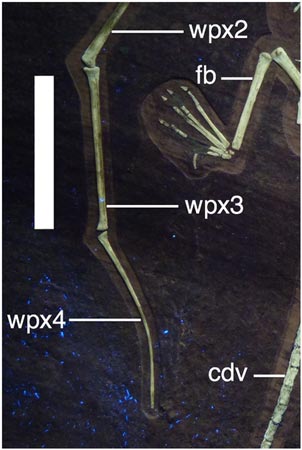New Highly Manoeuvrable Pterosaur Genus Described
Aerial Acrobat of the Jurassic
The lithographic limestone beds of Solnhofen in southern Germany are famous for their Jurassic vertebrate fossils. Scientists have studied these quarries for more than two hundred years and as the limestone is no longer commercially quarried so palaeontologists are usually left to themselves to search amongst the finely grained limestone layers, separately the layers like opening the pages of a book in the hope of finding new fossil material. Every once in a while, one of the fossils found, beautifully preserved in the fine limestone beds, provides scientists with an intriguing mystery. A little fossil of a pterosaur, a flying reptile, once thought to represent a juvenile Rhamphorhynchus has been re-examined and a research team have discovered that this specimen represents an entirely new genus and it might have been a spectacular aerial acrobat as well!
The Solnhofen deposits were laid down in a shallow, still lagoon. They have provided palaeontologists with evidence of over fifty fish species, numerous plant fossils and many different types of invertebrate. The most famous fossils found in these strata are those of the early bird Archaeopteryx (A. lithographica). However, this area has also provided many hundreds of pterosaur specimens. Pterosaurs are not closely related to birds and they are not dinosaurs, although they are members of the reptilian clade known as the Archosauria, something which they do have in common with the dinosaurs.
Two type of pterosaur are known from these Upper Jurassic deposits, short-tailed pterodactyloids and long-tailed rhamphorhynchoids. These fossils of flying reptiles from Germany have formed the foundation as to how palaeontologists classify the Pterosauria. However, very few actual species of flying reptile have been described from the Solnhofen material, despite the hundreds of pterosaur fossils found. It seems that Rhamphorhynchus spp. and the short-tailed Pterodactylus spp. were the dominant types, but a closer examination of what was thought to be a juvenile Rhamphorhynchus has led to scientists identifying a new species.
Manoeuvrable Pterosaur Genus
A fossil specimen, nearly complete and like many of the flying reptiles from these deposits, beautifully preserved, has been identified as a new type of Late Jurassic pterosaur. Although clearly closely related to Rhamphorhynchus and definitely a member of the rhamphorhynchoids, this new species has fewer teeth and a more flexible tail than the long-tailed pterosaur genus known as Rhamphorhynchus. Even more remarkably, the fourth bone of the finger that supports the skin membrane that makes up the wing was curved. The distal wing finger phalanges of both wings curved outwards. This distinguishes this type of pterosaur from all the others previously described, a new genus has been assigned – Bellubrunnus and a formal scientific name for this flying reptile has been established as Bellubrunnus rothgaenger. The genus name translates as Brunn beauty, to honour the German quarry where the fossil was found, the species name acknowledges the amateur fossil collector who first unearthed this specimen.
Aerial Master? An Illustration of Bellubrunnus rothgaenger
Picture credit: Matt Van Rooijen
Bellubrunnus rothgaenger
Although the skull is quite badly crushed, the international team of palaeontologists who studied this fossil are convinced that the curved wing finger phalanges are not the result of distortion or compression. Both of the distal wing bones (one in each wing) are curved to the same degree. This means that the aerodynamic properties of the leading edge of the wings of this creature would have been different from all other pterosaurs known to science.
At just fourteen centimetres long, the fossil material looked relatively unimpressive and indistinct from so many other Rhamphorhynchus fossils that had been found in the area before. It was the fossilised remains of a juvenile flying reptile but it has always been assumed it was an example of a Rhamphorhynchus species. However, once the prepared specimen had been viewed under ultra-violet light a lot more detail in the fossil material could be observed.
Right distal wing of the Specimen under UV Light Showing the Pronounced Curvature
Picture credit: PLoS One
The scale bar in the picture represents 2 cm, the key is as follows: wpx refer to the wing phalanx bones, the fourth being clearly curved in this photograph. The initials fb refer to the fibula (leg bone) and cdv indicate caudal vertebrae (tail bones).
The strange wings of this reptile, distinguish it from any other flying vertebrate. The shape of the wings would have made powered flight somewhat more difficult but the shape would have allowed this animal to turn and dart about very quickly. It was perhaps, the pterosaur equivalent of a stunt aeroplane. Being more manoeuvrable may have assisted this flying reptile which probably grew to be the size of a Magpie. It would have helped it to twist and turn in the air and snatch up insects as it flew.
To view models and replicas of flying reptiles and other prehistoric creatures: Flying Reptiles and Other Prehistoric Creatures.
The actual fossil was found in strata that is older than the main Solnhofen deposits, this site is still being explored and the research team are optimistic that more fossils of strange pterosaurs may be discovered.
The scientific paper: “A New Non-Pterodactyloid Pterosaur from the Late Jurassic of Southern Germany” by David W. E. Hone, Helmut Tischlinger, Eberhard Frey and Martin Röper published in PLoS One.



